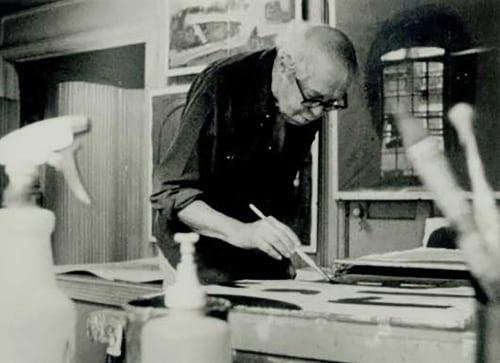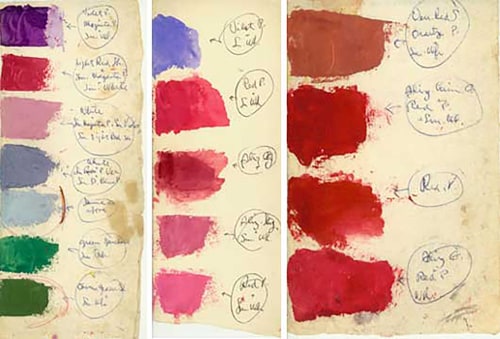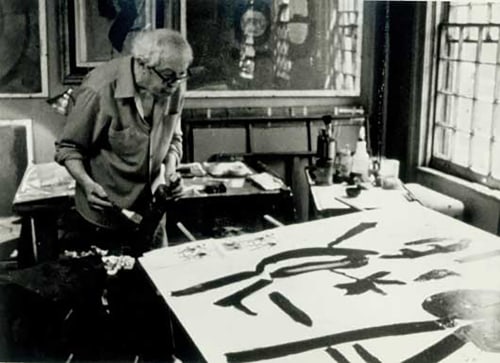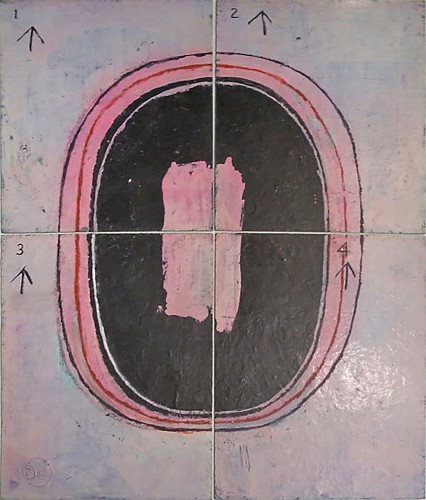---
“Glankoff’s greatest contribution to contemporary art is that of creating and perfecting an art-making procedure that, while based on printmaking, can fairly safely be considered a new technique....”
- JEFFREY WECHSLER
---

Sam Glankoff in his studio, 1981. Image taken from the documentary film on his life and art, "Re-arranging Short Dreams".
PAINTINGS ON PAPER
When Glankoff was asked to describe his process, he stated that he was...“using a printing method to make a painting.”
In the 1970s Sam Glankoff conceived an original format of transfer painting that has come to be described as “print-painting” - an elaborate process whereby he painted directly on multiple wood templates and transferred layers of color to Japanese paper panels by hand to create unique works of art. Tremendous color saturation of individual hues were achieved by multiple inkings and translucent overlays.
The “print-painting” process was devised by Glankoff, not only to create such effects, but also to permit the entire process, from beginning to end, to be carried out by the artist, without any assistance.
Today “print-painting” has been recognized as a unique development in the history of 20th century works on paper. Over the next few pages, we would like to walk you through this process...

A few of Glankoff's many hand mixed color charts
Glankoff produced preparatory drawings for each painting. A pencil grid, drawn through the colored pencil, pastel, gouache and ink images shows how Glankoff intended to proportionately scale up his designs. It was the studies that enabled him to achieve the spontaneity essential to his art.
Glankoff made color decisions at the beginning of the print-painting-making process by referring to color charts he himself had devised. The recipes on these charts called for water-soluble printer’s inks and casein colors - indicated on these charts by their chemical names - to be blended together.
Glankoff mixed his own colors and often achieved unique hues in his works by layering one transparent color over another. With the addition of glycerine, he was able to control the drying process and thus extend the color’s absorption into the Japanese paper panels as well as being able to last throughout the painting of multiple matrix boards.
---
“Through the alchemy of shapes and colors, Glankoff seeks to make the intangible visible.”
- AMEI WALLACH: ART CRITIC, 1981
---

Sam Glankoff in his Studio, 1981.
In preparation for Glankoff to scale-up the images from his preparatory drawings he primed the surface of the 19″ x 24″ Masonite boards. On his drafting table, he then combined these boards to make two-, and four-panel pieces. When he chose to work on a larger scale, six- and eight-panel works, the artist used simple sticks to act as a scaffold underneath the boards to extend the surface of the table.
Using the grid on the preparatory drawing as reference, Glankoff draws a similar grid in charcoal on the Masonite boards. The transferred image is drawn in charcoal as well, and then painted in acrylic, serving as a permanent matrix. As you see here, Glankoff is in the process of painting the scaled-up image on a six-panel piece. Each board will then be numbered.
In the 1950s Glankoff carved abstract images into small wood blocks and used gesso, caulking and string to build up surface textures in small editioned collage monotypes.
Caption
---
“Glankoff’s work speaks to an inner spirituality as well as a technical mastery that are unique achievements in the history of art.”
- MARILYN KUSHNER
---

The design matrix for a 4 Panel “circle” painting. One can also see a hint of a previous image underneath, as Glankoff often used and reused his boards.
A NEW PROCESS
In 1970, when Glankoff developed his process of making larger unique works, he continued to incise image and surface details directly into plywood boards, painting the design in oil paint.
But by the mid 1970s, he abandoned woodcut techniques, plywood and oil paint altogether and used faster drying neutral color acrylic paints on Masonite exclusively for his permanent design matrix.
Glankoff re-used these boards repeatedly. In this image of a “circle” you can see residue of the layer of pink printer’s ink that has been absorbed into the surface of the acrylic matrix.